65 Wings of Wonder: Butterfly Facts for Kids
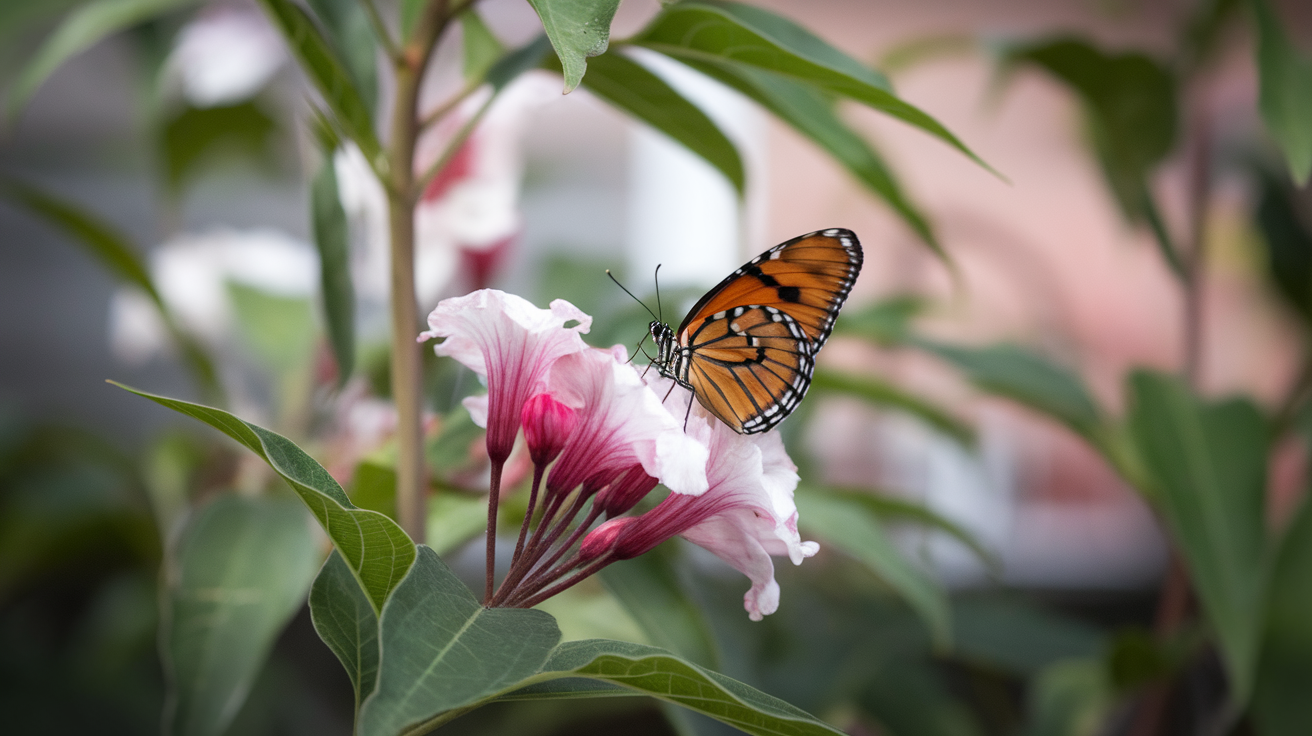
Butterflies are some of the most beautiful creatures on Earth. Their colorful wings and graceful flight have charmed people for centuries. But there’s so much more than meets the eye!
Have you ever watched a butterfly dancing from flower to flower and wondered about the secrets it holds?
They can taste with their feet, see colors we can’t even imagine, and travel thousands of miles without a GPS! Some butterflies are smaller than a coin, while others have wings bigger than dinner plates.
They can predict the weather, play dead to fool enemies, and even survive freezing temperatures with their built-in antifreeze.
Get ready to learn about butterflies like never before! From their remarkable abilities to their unusual behaviors, these facts will reveal just how special these creatures are.
What are Butterflies?
Butterflies are excellent flying insects that start their lives as tiny caterpillars!
They undergo an incredible transformation called metamorphosis, during which they build a chrysalis around themselves and change entirely into beautiful, winged creatures.
Their colorful wings are covered in tiny scales that create stunning patterns, helping them fly gracefully through the air.
Butterflies are nature’s helpers because they pollinate flowers as they drink sweet nectar, helping plants make seeds and grow new flowers.
They also serve as food for birds and other animals, making them an important part of the food chain.
Without butterflies, many plants wouldn’t be able to reproduce, and our world would be much less colorful and vibrant.
General Butterfly Facts

Butterflies belong to a group of insects called Lepidoptera, which means “scale wing.” Their wings are covered in tiny, colorful scales that create those beautiful patterns we love to see.
These scales aren’t just pretty – they help butterflies stay warm, communicate, and even scare away enemies.
1. Wings
Butterflies have four wings, not two, like many people think. They have a pair of front wings and a pair of back wings that work together in a figure-eight pattern when they fly.
This unique wing structure allows them to hover, glide, and make sudden directional changes with remarkable precision.
2. Transparency
Butterfly wings are see-through! What we see as color comes from tiny scales that cover the clearwing surface underneath.
These microscopic scales reflect light in different ways, creating the brilliant colors and patterns we admire in nature.
3. Diversity
There are about 20,000 different types of butterflies around the world. Colombia has the most species, with over 3,600 different kinds!
Each species has adapted to specific environments and food sources, making butterflies one of nature’s most varied insect groups.
4. Complete Change Process
The most incredible thing about butterflies is their complete change, known as metamorphosis. They go through four stages: egg, caterpillar, chrysalis, and adult butterfly.
This process represents one of nature’s most remarkable developments from one life form to another.
5. Appetite
Caterpillars can eat up to 27,000 times their body weight before they’re ready to change into butterflies. That’s like a human eating 1,350 tons of food!
This massive consumption provides all the energy needed for their transformation into an adult form.
6. Growth
Once hatched from an egg, a caterpillar can grow 30,000 times bigger before it forms its chrysalis.
That’s like a baby growing to be the size of a blue whale! This rapid growth happens through multiple molting stages as the caterpillar sheds its skin.
7. Adaptation
Inside the chrysalis, the caterpillar’s body turns into a gel-like liquid. Special cells rebuild the body into a butterfly – it’s like nature’s own magic trick!
This process takes anywhere from a few weeks to several months, depending on the species.
8. Defense
Some chrysalises can make sounds to scare away predators. They click or vibrate to warn enemies to stay away. This defense mechanism helps protect the vulnerable developing butterfly during its most helpless stage.
9. Preparation
After coming out of the chrysalis, butterflies hang upside down for hours while fluids fill their wings. They need gravity’s help to get ready for their first flight.
During this time, their wings expand and harden into the proper shape for flying.
10. Waste
Before flying for the first time, butterflies get rid of waste from their chrysalis stage. This red liquid is called meconium and smells terrible!
This process clears their digestive system and prepares them for their new diet of nectar.
11. Temperature
Butterflies are cold-blooded and need their body temperature to reach at least 86 degrees Fahrenheit before they can fly. This is why you see them sunbathing on warm days.
They position themselves to absorb maximum sunlight, which warms their flight muscles.
12. Speed
The fastest butterflies can fly up to 37 miles per hour! Skipper butterflies are known for being the speediest. Their rapid flight helps them escape predators and compete for mates and food sources.
13. Distance
Painted Lady butterflies can fly up to 30 miles per hour and travel 100 miles in a single day during migration. Some species travel thousands of miles annually, crossing continents and oceans.
Their flight abilities rival those of many birds.
Fun About Butterfly Behavior
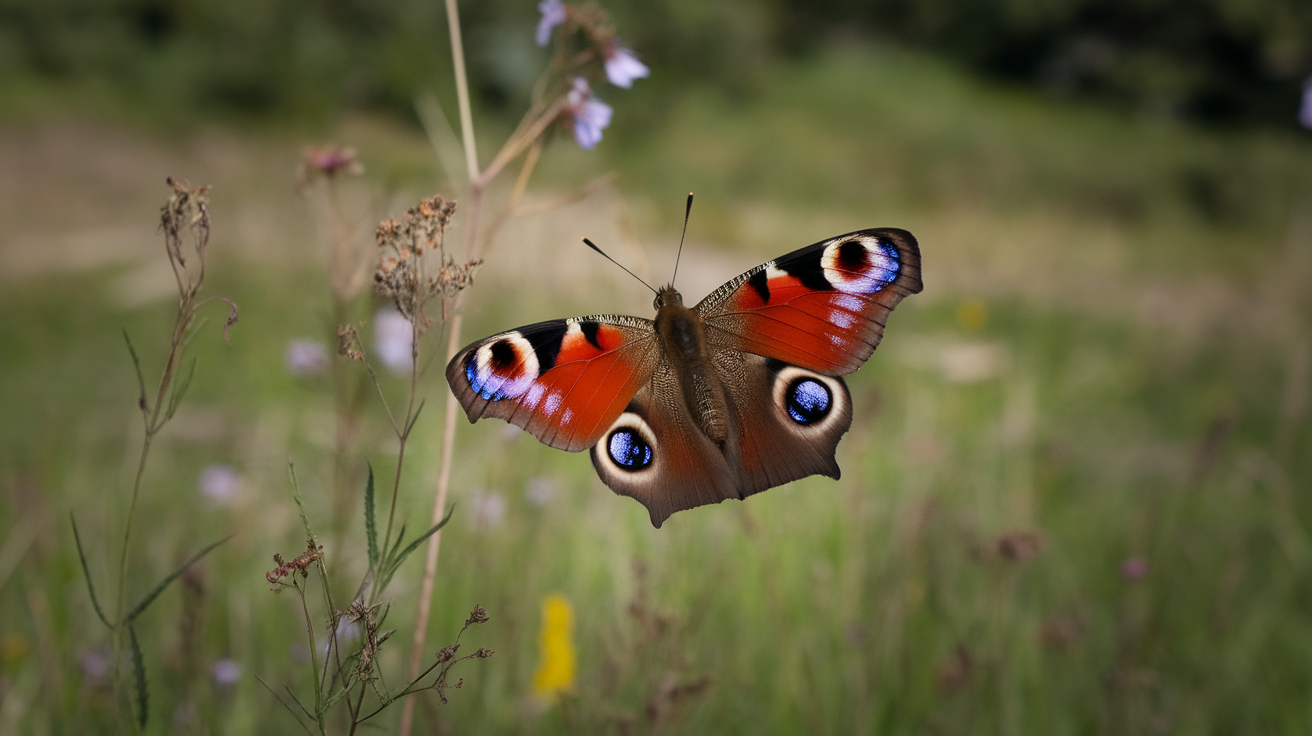
Some butterflies make incredible trips that would put human travelers to shame!
14. Strength
Despite weighing less than a paperclip, Painted Lady butterflies are extreme fliers and can travel thousands of miles.
Their lightweight bodies and powerful wing muscles create an efficient flying machine. This strength-to-weight ratio makes them one of nature’s most impressive travelers.
15. Migration
Painted Lady butterflies make the longest migration of any butterfly – a 9,000-mile round trip from tropical Africa to the Arctic Circle.
This takes several generations to complete. Each generation plays a crucial role in this epic movement across continents and climates.
16. Travel
Monarch butterflies travel up to 3,000 miles from Canada to Mexico each fall. What’s remarkable is that it takes four generations to complete the full round trip!
The final generation of each year makes the entire southward trip, while spring generations make shorter northward segments.
17. Distribution
Butterflies can be found on every continent except Antarctica. They’ve adapted to live in many different climates, even cold places like Alaska and Greenland.
This wide distribution shows their remarkable ability to adapt to various environmental conditions.
18. Communication
Butterflies communicate using chemical signals called pheromones. These invisible messages help them find mates and recognize their own species.
Each species has its own unique chemical signature that prevents confusion during mating season.
19. Dancing
Some butterflies perform special dances in the air, spiraling around each other like they’re waltzing in the sky.
These courtship flights can last for hours and involve complex aerial maneuvers. The male typically initiates these displays to impress potential mates.
20. Attraction
Male butterflies often have bright colors or special patterns that they use to attract females during mating season. Scent signals and flight patterns complement these visual displays.
Competition between males can be fierce, with the most colorful often winning mates.
21. Pollination
Butterflies are important pollinators. As they move from flower to flower collecting nectar, they help plants reproduce.
Their role in pollination is especially crucial for wildflowers and some agricultural crops that depend on insect visitors.
22. Preferences
Different butterfly species prefer different flowers. Some like red flowers, others prefer yellow or purple ones.
These preferences have evolved over millions of years, resulting in specialized relationships between specific butterflies and their preferred plants.
23. Agriculture
Butterflies help pollinate many plants that produce fruits and vegetables we eat, making them important for our food supply.
They’re particularly valuable for crops like blueberries, cranberries, and various herbs. Their decline in some areas has raised concerns about agricultural productivity.
24. Tasting
Butterflies taste with their feet! When they land on a flower, special sensors on their feet tell them if it’s good to eat or the right place to lay eggs.
This ability helps them make quick decisions about food sources and suitable places for their offspring.
25. Proboscis
The long, straw-like tongue of a butterfly is called a proboscis. They use it like a drinking straw to sip nectar from flowers. When not in use, this flexible tube coils up like a garden hose under their head.
26. Diet
Butterflies don’t just eat nectar. They also consume tree sap, fruit juice, and even animal tears and sweat for added nutrients. This varied diet helps them obtain minerals and salts that nectar alone cannot provide.
Butterfly Habitats
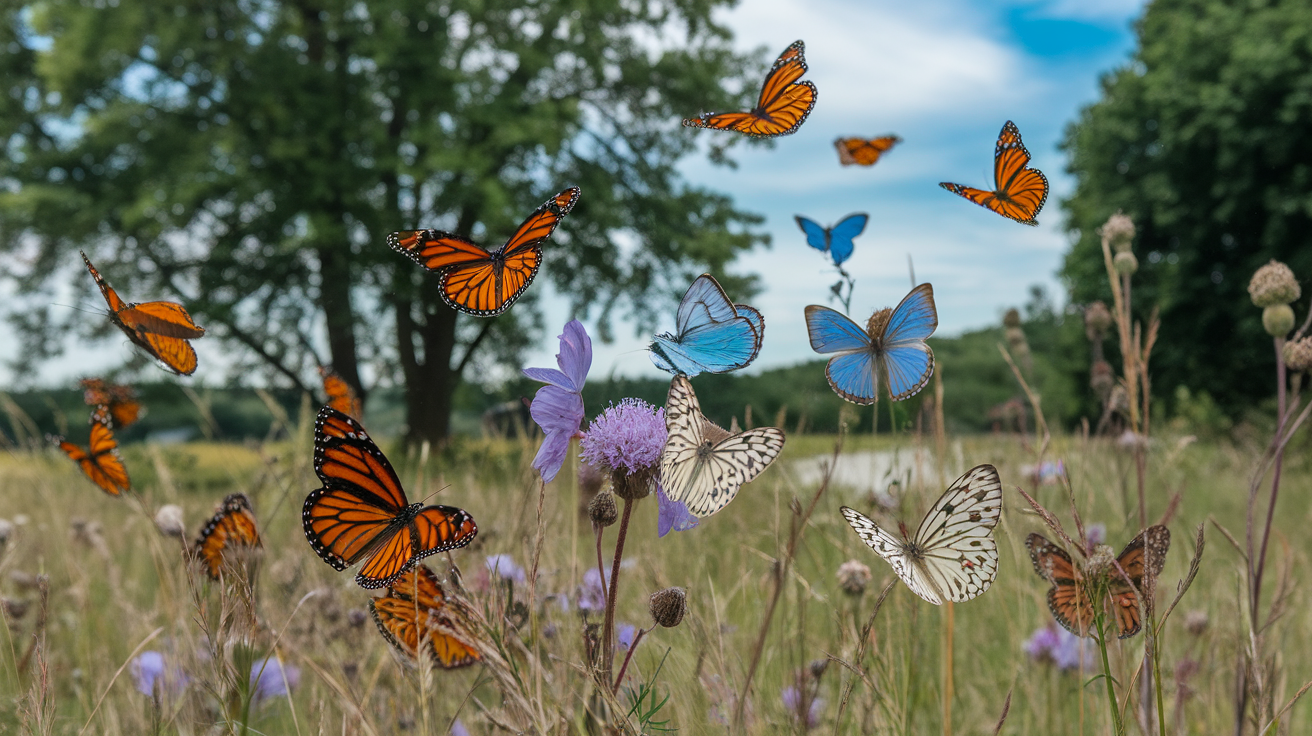
Butterflies live in many different places around the world, each adapted to their specific environment.
27. Habitat
Butterflies prefer sunny, sheltered areas with lots of flowering plants. Gardens, meadows, and forest edges are perfect butterfly homes.
These environments provide both food sources and protection from harsh weather conditions.
28. Specificity
Some butterflies require specific plants on which to lay their eggs. For example, Monarch butterflies only lay eggs on milkweed plants.
This specialization ensures that caterpillars have the exact food they need to survive and develop properly.
29. Rainforests
Tropical rainforests are home to the most diverse butterfly species due to their warm, humid climate and abundant plant life.
The constant temperature and year-round flowering plants create ideal conditions for the reproduction and survival of butterflies.
30. Nocturnal
The Northern Pearly Eye butterfly is unusual because it flies at night, unlike most butterflies that are active during the day. These night-flying species have evolved different strategies for finding food and mates in darkness.
31. Antifreeze
Arctic butterflies have special antifreeze in their bodies that help them survive freezing temperatures. This biological adaptation allows them to remain active in conditions that would be lethal to other butterfly species.
32. Adaptation
Desert butterflies often have pale colors that help reflect heat and keep them cool in hot climates.
They also tend to be more active during cooler morning and evening hours when temperatures are more manageable.
33. Vision
Butterflies can see ultraviolet light, which humans cannot see. This helps them find flowers and recognize other butterflies.
Many flowers have ultraviolet patterns that serve as landing strips, invisible to the human eye but visible to butterflies.
34. Camouflage
Many butterflies have eye spots on their wings that look like the eyes of larger animals. This tricks predators into thinking they’re facing a dangerous creature.
Some species also have wing patterns that resemble leaves or bark when their wings are closed.
35. Indicators
Butterflies are indicator species, which means their presence shows that an ecosystem is healthy. Scientists monitor butterfly populations to assess environmental changes and pollution levels in different areas.
36. Seeds
By moving pollen from one flower to another, butterflies help create seeds that grow into new plants.
This pollination service is essential for maintaining plant diversity and supporting other wildlife that depend on these plants.
37. Food Chain
Butterflies serve as a food source for many animals, including birds, spiders, and frogs, making them a crucial part of the food chain.
Both adult butterflies and caterpillars provide nutrition for different predator species throughout their life cycles.
38. Keystone
Some butterfly species are considered keystone species, meaning that many other animals and plants depend on them for their survival.
The loss of these critical species can cause cascading effects throughout their entire ecosystem.
39. Gardens
Butterfly gardens help support local ecosystems by providing food sources for other insects and animals as well.
These specially designed spaces can increase biodiversity and create corridors for wildlife movement in urban and suburban areas.
Fun and Strange Butterfly Information
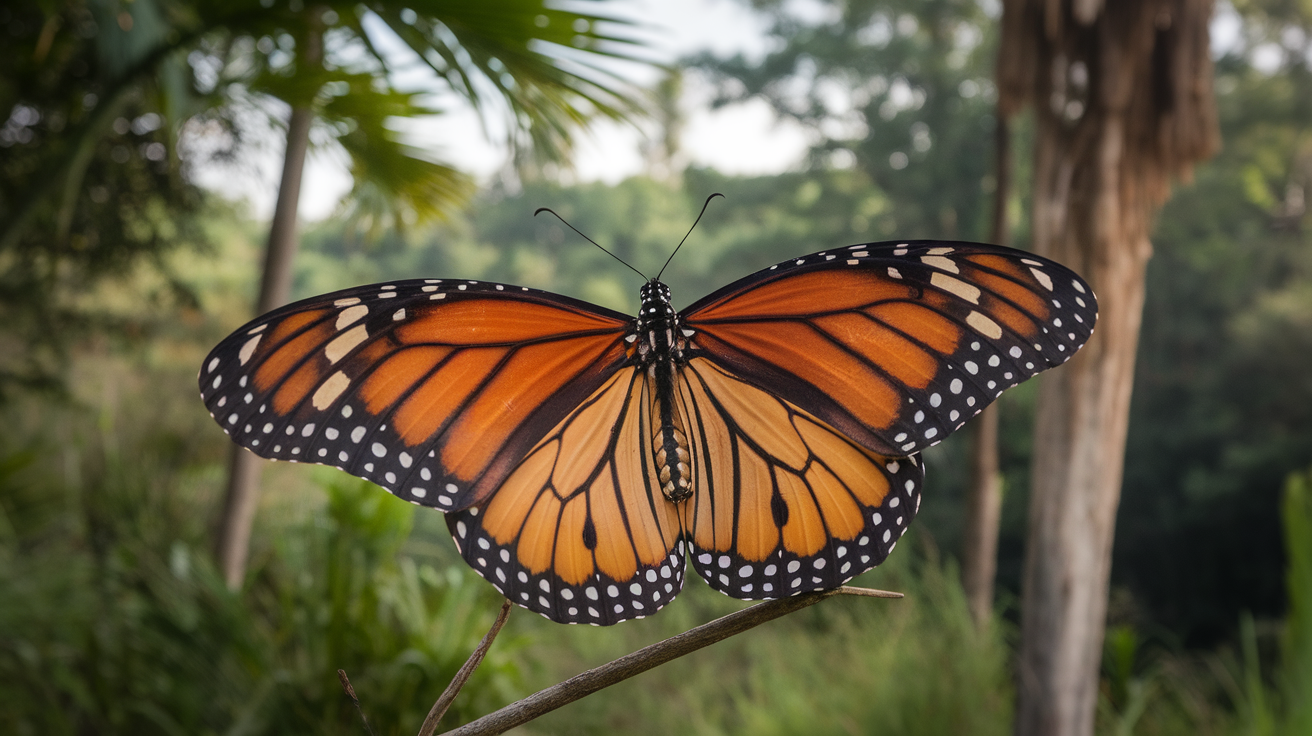
From tiny butterflies smaller than coins to giants with dinner plate-sized wings, the butterfly world is full of incredible extremes.
You’ll learn about butterflies that can predict the weather, nearly invisible ones, and some with superpowers that seem straight out of a science fiction movie.
40. Smallest
The Western Pygmy Blue is the smallest butterfly in the world. Its wings span only half an inch – smaller than a quarter!
This tiny size allows it to fit through spaces that would be impossible for larger butterflies to access.
41. Resilience
Despite being tiny, the Western Pygmy Blue is a strong flier and can travel great distances.
Their small size actually helps them conserve energy while flying, making them surprisingly efficient travelers for their scale.
42. Lifespan
Most butterflies live only 2-5 weeks as adults, but the Brimstone butterfly can live up to a year by hibernating through winter.
This extended lifespan is unusual among butterfly species and necessitates special adaptations for surviving cold weather.
43. Record
The longest-living butterfly on record was a Brimstone that lived for 13 months! This exceptional longevity was documented by researchers who tracked individual butterflies through multiple seasons.
44. Transparency
Glasswing butterflies have apparent wings that make them nearly invisible to predators.
This see-through quality provides excellent camouflage in their natural rainforest habitat, where dappled light creates similar transparency effects.
45. Structure
The transparent wings of Glasswing butterflies are covered in tiny hairs that prevent light from reflecting off them.
These microscopic structures work like an anti-reflective coating on glasses, maintaining their invisibility from multiple angles.
46. Weather
Some butterflies can sense changes in air pressure and hide before storms arrive, like having their own weather radar! This ability enables them to avoid hazardous flying conditions and seek shelter when necessary.
47. Eyes
Butterflies have compound eyes composed of up to 17,000 tiny lenses, which gives them exceptional vision.
Each lens captures a slightly different angle, creating a mosaic-like view that excels at detecting movement and recognizing patterns.
48. Largest
The Queen Alexandra’s Birdwing is the largest butterfly in the world, with wings spanning nearly 12 inches across!
This massive size makes it larger than many birds, and it’s found only in the rainforests of Papua New Guinea.
49. Breathing
Butterflies don’t have lungs. Instead, they breathe through tiny holes called spiracles along their sides.
This system allows air to flow directly to their organs without needing a central respiratory system like mammals have.
50. Skeleton
Butterflies have exoskeletons, meaning their “bones” are on the outside of their bodies like armor.
This external skeleton protects while keeping their body weight minimal for efficient flight.
51. Puddling
Male butterflies drink from mud puddles to get essential minerals. This behavior is called “puddling.”
The minerals they absorb, especially sodium, are crucial for reproduction and are passed to females during mating.
52. Territory
Butterflies can be territorial and will fight each other for the best sunny spots to warm up.
Males often establish territories around good basking sites or flowering plants, chasing away competitors with aggressive flight displays.
Butterfly Superstitions and Mythology
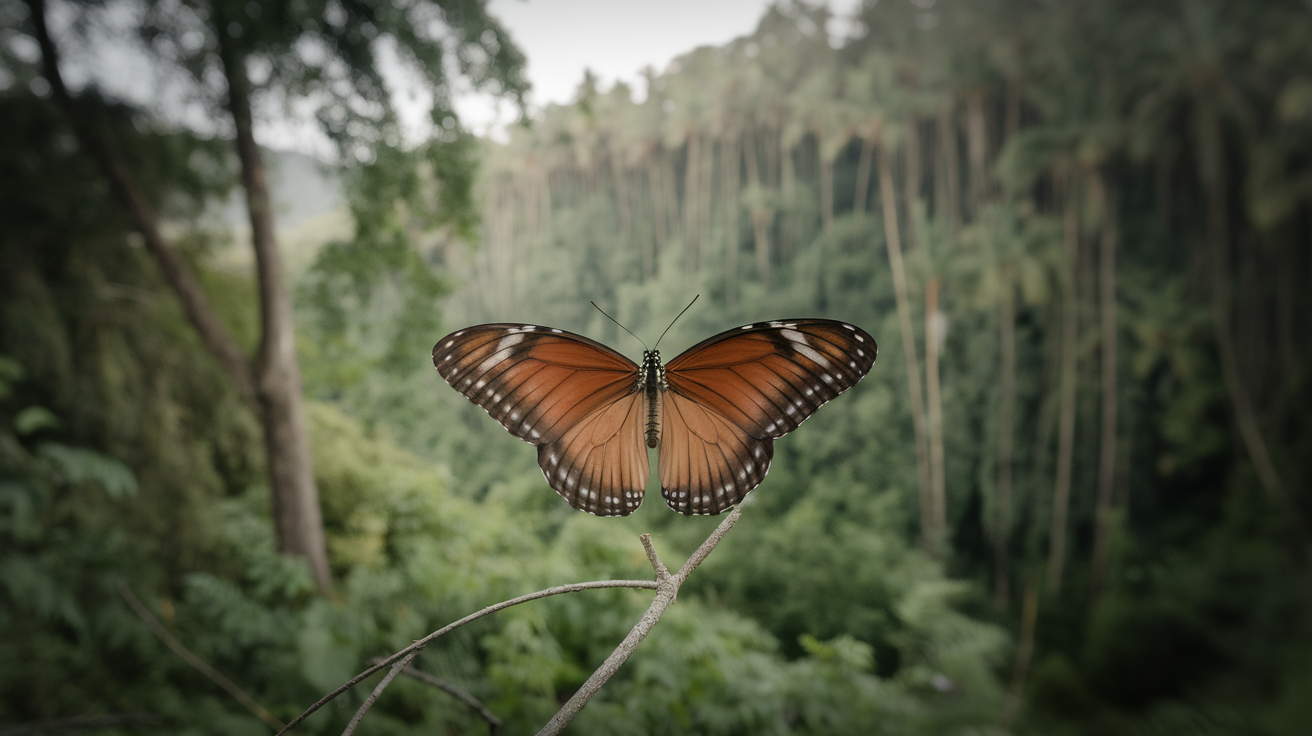
Throughout history, butterflies have appeared in stories and beliefs from cultures around the world.
53. Greek
In ancient Greek mythology, butterflies represented the soul and life after death. The Greeks believed that butterflies were proof that the soul could exist independently of the body.
This symbolism connected the butterfly’s metamorphosis to spiritual rebirth and eternal life.
54. Native American
Some Native American tribes believed butterflies carried wishes and prayers to the spirit world. Many tribes saw butterflies as messengers between the physical and spiritual realms.
Their colorful wings were thought to carry the hopes and dreams of people to the ancestors.
55. Japanese
In Japanese culture, butterflies symbolize the souls of loved ones who have passed away. They are often seen as visitors bringing comfort and messages from departed family members.
Japanese gardens often feature plants that attract butterflies, fostering a sense of spiritual connection.
56. Egyptian
Ancient Egyptian art from over 3,000 years ago depicts butterflies, indicating that people have long been drawn to them.
These early civilizations recognized butterflies as symbols of rebirth and renewal, much like their own beliefs about life after death. Butterfly motifs appeared on jewelry, pottery, and tomb paintings.
57. Playing Dead
The Mourning Cloak butterfly can play dead to fool predators into leaving it alone. When threatened, it will suddenly drop to the ground and remain motionless with wings folded.
This death-feigning behavior often causes predators to lose interest and move on to other prey.
58. Rain
Butterflies hide during rainstorms because heavy raindrops can damage their wings. A single raindrop can weigh more than a butterfly, making flight impossible during storms.
They seek shelter under leaves, in tree bark crevices, or other protected areas until the weather clears.
59. Rest
Butterflies don’t sleep because they don’t have eyelids, but they do rest at night and on cloudy days. During these rest periods, they become inactive and hang from branches or hide in vegetation.
Their body temperature drops, and they enter a state similar to sleep but without the brain activity patterns of proper sleep.
60. Waste
Adult butterflies don’t poop because they use all the nutrients from their nectar for energy. Their liquid diet is so efficiently processed that there’s virtually no solid waste to eliminate.
This efficient system helps keep their body weight minimal for optimal flight performance.
61. Yellow
Yellow butterflies often represent joy and happiness in folklore. Many cultures associate these bright, sunny-colored butterflies with positive emotions and good fortune.
Seeing a yellow butterfly is often considered a sign that happy times are coming.
62. Blue
Blue butterflies symbolize peace and calm feelings. Their cool, soothing color is associated with tranquility and serenity in many cultural traditions.
Blue butterflies are often seen as bringers of peaceful energy and emotional healing.
63. White
White butterflies are often seen as symbols of purity and spiritual messages. Many people believe that white butterflies carry messages from guardian angels or departed loved ones.
Their pristine appearance makes them popular symbols in wedding ceremonies and religious art.
64. Etymology
The word “butterfly” originates from an Old English term meaning “butter-colored fly,” possibly referring to the yellowish color of butterflies.
Some historians believe it may have come from the butter-yellow color of common European species. The term has remained largely unchanged for over 1,000 years.
65. Groups
A group of flying butterflies is called a “flutter,” while a group of resting butterflies is called a “roost,” and when caterpillars gather together, they’re called an “army.”
These collective nouns reflect the different behaviors butterflies exhibit in various situations. Large migrations can create flutters of thousands of butterflies moving together.
Time to Spread Your Wings and Fly Into Action
You’ve learned incredible butterfly facts – now it’s time to put that knowledge to work and become a real-life butterfly detective.
Grab your notebook, head outside, and launch on your butterfly-watching expedition today.
Butterflies truly are some of nature’s most incredible creatures! From their ability to taste with their feet to their thousands of miles of migration, these colorful insects prove that the natural world is full of wonder and surprises.
The next time you see a butterfly in your garden or at a park, remember all these incredible facts and take a moment to appreciate the remarkable creature you’re watching.
Which butterfly fact surprised you the most? Share your favorite find from our list and tell us about any butterflies you’ve spotted in your backyard!






